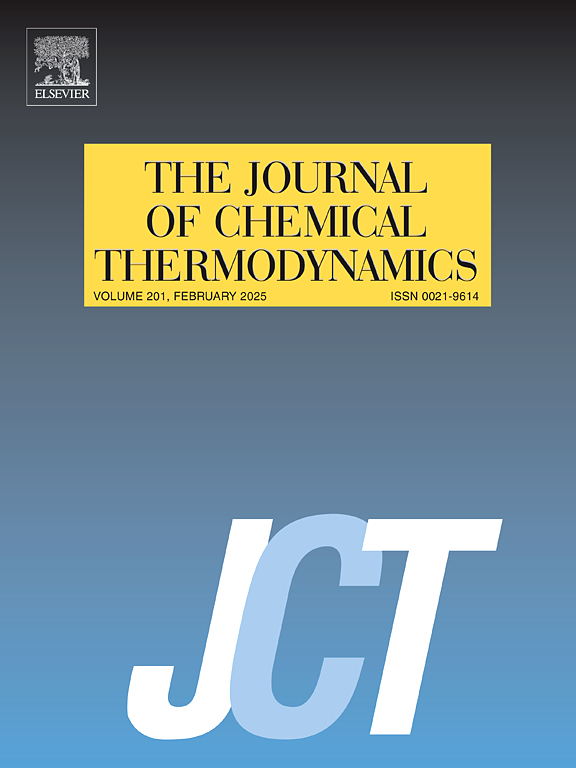Thermodynamic analysis of excess molar enthalpy dynamics in mixtures containing ethanol, methanol, and alkoxyethanols as biofuels for enhanced combustion performance
IF 2.2
3区 工程技术
Q3 CHEMISTRY, PHYSICAL
引用次数: 0
Abstract
The pressing need to find alternative fuels for environmental reasons has spurred the development of biofuels derived from biomass. These renewable energy sources reduce reliance on petroleum and lower greenhouse gas emissions. Ethanol and methanol are key biofuels that act as oxygenated additives, improving combustion efficiency and reducing air pollution. Ethanol, with its high oxygen content, boosts engine performance and cuts emissions, while methanol offers a cost-effective and versatile option. Research on alkoxyethanols-gasoline blends has shown substantial decreases in toxic pollutants, highlighting the importance of thermodynamic insights for advancing cleaner energy solutions. This study presents experimental data on excess molar enthalpies of fluid mixtures, encompassing ethanol and methanol combined with various alkoxyethanols, measured at two temperatures: 298.15 K and 313.15 K. Excess molar enthalpies were determined using a quasi-isothermal flow calorimeter at p = 0.1 MPa. Furthermore, the measured data were analyzed using a Redlich-Kister equation for fitting and correlated using Non-Random Two-Liquid (NRTL) and Universal Quasi-Chemical (UNIQUAC) models. The molecular interactions and thermodynamic behavior of the various studied binary mixtures at different temperatures are thoroughly examined and discussed.
含有乙醇、甲醇和烷氧基乙醇的混合物中过量摩尔焓动态的热力学分析,作为生物燃料提高燃烧性能
出于环保原因,人们迫切需要寻找替代燃料,这推动了从生物质中提取的生物燃料的发展。这些可再生能源减少了对石油的依赖,降低了温室气体排放。乙醇和甲醇是主要的生物燃料,可作为含氧添加剂,提高燃烧效率,减少空气污染。乙醇含氧量高,可提高发动机性能并减少排放,而甲醇则是一种具有成本效益的多功能选择。有关烷氧基乙醇汽油混合物的研究表明,有毒污染物大幅减少,这突出了热力学研究对于推进清洁能源解决方案的重要性。本研究提供了在两种温度下测量的流体混合物过量摩尔焓的实验数据,包括乙醇和甲醇与各种烷氧基乙醇的混合物:过量摩尔焓是在 p = 0.1 兆帕的条件下使用准等温流动量热仪测定的。此外,还使用 Redlich-Kister 方程对测量数据进行了拟合分析,并使用非随机双液(NRTL)和通用准化学(UNIQUAC)模型对测量数据进行了相关分析。对所研究的各种二元混合物在不同温度下的分子相互作用和热力学行为进行了深入研究和讨论。
本文章由计算机程序翻译,如有差异,请以英文原文为准。
求助全文
约1分钟内获得全文
求助全文
来源期刊

Journal of Chemical Thermodynamics
工程技术-热力学
CiteScore
5.60
自引率
15.40%
发文量
199
审稿时长
79 days
期刊介绍:
The Journal of Chemical Thermodynamics exists primarily for dissemination of significant new knowledge in experimental equilibrium thermodynamics and transport properties of chemical systems. The defining attributes of The Journal are the quality and relevance of the papers published.
The Journal publishes work relating to gases, liquids, solids, polymers, mixtures, solutions and interfaces. Studies on systems with variability, such as biological or bio-based materials, gas hydrates, among others, will also be considered provided these are well characterized and reproducible where possible. Experimental methods should be described in sufficient detail to allow critical assessment of the accuracy claimed.
Authors are encouraged to provide physical or chemical interpretations of the results. Articles can contain modelling sections providing representations of data or molecular insights into the properties or transformations studied. Theoretical papers on chemical thermodynamics using molecular theory or modelling are also considered.
The Journal welcomes review articles in the field of chemical thermodynamics but prospective authors should first consult one of the Editors concerning the suitability of the proposed review.
Contributions of a routine nature or reporting on uncharacterised materials are not accepted.
 求助内容:
求助内容: 应助结果提醒方式:
应助结果提醒方式:


